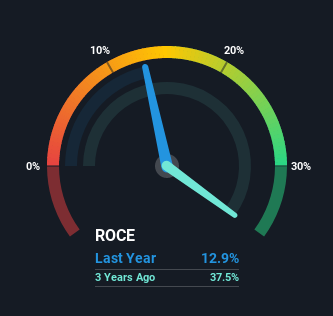- France
- /
- Professional Services
- /
- ENXTPA:MLCIO
Here's What's Concerning About Groupe CIOA's (EPA:MLCIO) Returns On Capital
If we want to find a potential multi-bagger, often there are underlying trends that can provide clues. Amongst other things, we'll want to see two things; firstly, a growing return on capital employed (ROCE) and secondly, an expansion in the company's amount of capital employed. Basically this means that a company has profitable initiatives that it can continue to reinvest in, which is a trait of a compounding machine. However, after briefly looking over the numbers, we don't think Groupe CIOA (EPA:MLCIO) has the makings of a multi-bagger going forward, but let's have a look at why that may be.
Understanding Return On Capital Employed (ROCE)
For those who don't know, ROCE is a measure of a company's yearly pre-tax profit (its return), relative to the capital employed in the business. Analysts use this formula to calculate it for Groupe CIOA:
Return on Capital Employed = Earnings Before Interest and Tax (EBIT) ÷ (Total Assets - Current Liabilities)
0.13 = €1.7m ÷ (€30m - €16m) (Based on the trailing twelve months to December 2020).
Therefore, Groupe CIOA has an ROCE of 13%. In absolute terms, that's a pretty normal return, and it's somewhat close to the Professional Services industry average of 12%.
See our latest analysis for Groupe CIOA

While the past is not representative of the future, it can be helpful to know how a company has performed historically, which is why we have this chart above. If you want to delve into the historical earnings, revenue and cash flow of Groupe CIOA, check out these free graphs here.
What The Trend Of ROCE Can Tell Us
On the surface, the trend of ROCE at Groupe CIOA doesn't inspire confidence. Around five years ago the returns on capital were 40%, but since then they've fallen to 13%. And considering revenue has dropped while employing more capital, we'd be cautious. This could mean that the business is losing its competitive advantage or market share, because while more money is being put into ventures, it's actually producing a lower return - "less bang for their buck" per se.
On a side note, Groupe CIOA has done well to pay down its current liabilities to 56% of total assets. So we could link some of this to the decrease in ROCE. Effectively this means their suppliers or short-term creditors are funding less of the business, which reduces some elements of risk. Some would claim this reduces the business' efficiency at generating ROCE since it is now funding more of the operations with its own money. Keep in mind 56% is still pretty high, so those risks are still somewhat prevalent.
In Conclusion...
From the above analysis, we find it rather worrisome that returns on capital and sales for Groupe CIOA have fallen, meanwhile the business is employing more capital than it was five years ago. We expect this has contributed to the stock plummeting 79% during the last five years. Unless there is a shift to a more positive trajectory in these metrics, we would look elsewhere.
One more thing to note, we've identified 3 warning signs with Groupe CIOA and understanding these should be part of your investment process.
While Groupe CIOA isn't earning the highest return, check out this free list of companies that are earning high returns on equity with solid balance sheets.
If you decide to trade Groupe CIOA, use the lowest-cost* platform that is rated #1 Overall by Barron’s, Interactive Brokers. Trade stocks, options, futures, forex, bonds and funds on 135 markets, all from a single integrated account. Promoted
New: Manage All Your Stock Portfolios in One Place
We've created the ultimate portfolio companion for stock investors, and it's free.
• Connect an unlimited number of Portfolios and see your total in one currency
• Be alerted to new Warning Signs or Risks via email or mobile
• Track the Fair Value of your stocks
This article by Simply Wall St is general in nature. We provide commentary based on historical data and analyst forecasts only using an unbiased methodology and our articles are not intended to be financial advice. It does not constitute a recommendation to buy or sell any stock, and does not take account of your objectives, or your financial situation. We aim to bring you long-term focused analysis driven by fundamental data. Note that our analysis may not factor in the latest price-sensitive company announcements or qualitative material. Simply Wall St has no position in any stocks mentioned.
*Interactive Brokers Rated Lowest Cost Broker by StockBrokers.com Annual Online Review 2020
Have feedback on this article? Concerned about the content? Get in touch with us directly. Alternatively, email editorial-team (at) simplywallst.com.
About ENXTPA:MLCIO
Mediocre balance sheet and slightly overvalued.
Market Insights
Community Narratives



